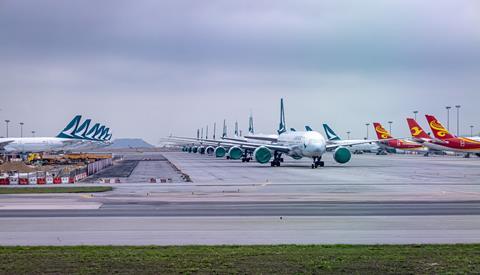Beleaguered Cathay Pacific will move about 40% of its fleet to long-term storage locations overseas, as it adjusts downwards its forecasted capacity for the coming months.
In its monthly traffic results for August, Cathay confirms that it is parking a significant number of aircraft overseas, given that it “will be operating just a fraction of our services in the foreseeable future”.

This is an upward adjustment of earlier figures of about a third of the Cathay fleet, which was disclosed during its earnings briefing in August.
The carrier said then that a first batch of aircraft was being moved to Alice Springs, and that it was in discussions with other locations at the same time. Cathay group chairman Patrick Healy added that the move was a “prudent asset-management decision that is necessary to ensure that the condition and value of our aircraft are maintained while they are not flying”.
Cathay, which reported record losses for the six months ended 30 June, was also in talks with Airbus and Boeing about deferring its orders. The carrier in July reached an agreement with Airbus to delay taking A350s and A321neos by up to two years. It added that it was in “advanced negotiations” with Boeing about delaying the 777-9s, which it has 21 on order.
For August, Cathay notes that passenger travel demand continues to be weak, due to travel restrictions imposed globally to curb the spread of the coronavirus outbreak.
Cathay and sister carrier Cathay Dragon carried 35,773 passengers for the month, fewer passengers than it did for July. This constitutes a 98.8% decline year on year.
ASKs for the month plummeted about 92% compared to the same month last year, while RPKs contracted 98%.
Overall passenger load factor fell below 20% for the first time this year, at 19.9%. This is a 60 percentage point decline year on year.
Cathay blamed the continued weak travel sentiment amid new waves of outbreak in its key markets as a reason why passenger traffic results fared worse in August.
Ronald Lam, Cathay’s group chief commercial and customer officer, says: “With no new destinations being resumed in August, we saw only minimal increase in passenger flight capacity compared to the previous month. We operated just 7.8% of our normal capacity – a marginal increase from 7.1% in July – however, our overall passenger volume was down month on month and our load factor dipped below 20%.”
Lam adds that the carrier has revised downwards its projected capacity for this month and October to about 10%, given that it has not seen “solid signs of immediate improvement”.
The carrier’s freight business, meanwhile, notched a stronger performance for the month, with its cargo tonnage and load factors about the same as July’s.
The Cathay group reported a record HK$8.7 billion ($1.12 billion) operating loss for the six months ended 30 June, as it was hit severely by the impact of the pandemic.


























